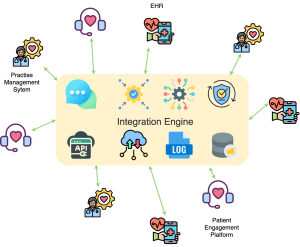Digitization: A Change That Can Make or Break Your Healthcare System
“Change.” It’s a word that often stirs up excitement, hinting at growth and new possibilities, more so in healthcare because the stakes are high. But if we’re honest, every conversation about change also brings a quiet tension—one that any healthcare leader knows well. There’s that lingering question: How will this impact our system, our patients, our team? For better or worse? That caution isn’t just justified; it’s essential in an industry where every decision matters. Each move in transforming a healthcare business has to be considered carefully, with each risk weighed against the potential benefit.
Yet, staying too comfortable, clinging to what’s familiar, has its own risks. Ignoring change for too long can mean missed opportunities, lost potential—the very things that could have advanced an organization to the next level. In healthcare, adapting thoughtfully can be the difference between truly thriving and just getting by.
Careful evolution of change: Digitizing Healthcare Through Seamless Integration
In healthcare, change doesn’t tiptoe in—it makes a grand entrance, demanding your attention! How you embrace it can either elevate your operations to rockstar status or leave you scrambling to keep up. This blog shines a spotlight on the key players—patients, providers, staff, case managers, payers, and diagnostic labs—and how digitizing their interactions can transform healthcare delivery. Imagine swapping chaos for clarity and turning everyday processes into a symphony of efficiency.
Imagine trying to solve a puzzle with just one piece—it doesn’t quite work, does it? That’s what relying on a single application in today’s healthcare world feels like. The real game-changer is integration—bringing together the best systems to work as a dream team. When done right, integration becomes your secret weapon: simplifying workflows, breaking down communication barriers, and setting the stage for scalable growth. But if done wrong? Well, that’s like trying to assemble a puzzle with pieces that don’t fit—data silos pile up, inefficiencies creep in, and your carefully built system risks crumbling. Integration is the art of making it all click—get it right, and you’re unstoppable!
The Make Moment: How an Integration Engine Connects Healthcare Applications
Enough with the storytelling—let’s dive into how this integration engine brings order to the chaos of disconnected systems like PMS, EHRs, and patient engagement platforms. Let’s explore the core components of the integration engine that make this seamless harmony possible.
Components of Integration Engine
- Message Broker
Acts as the middleman for communication between systems. It ensures messages (data) are reliably sent and received, even if one system is temporarily unavailable. - API Gateway
Manages all API traffic between systems, handling authentication, security, and rate limiting. - Data Transformation Layer
Converts data from one format to another so different systems can understand it (e.g., JSON from the engagement platform to HL7 for the EHR). - Orchestration Layer
Coordinates complex workflows and ensures all steps in a process are executed in the right order. - Data Repository
Acts as temporary storage for logs, analytics, and intermediate data during workflows. - Compliance
Tracks every data exchange to ensure compliance with regulations like HIPAA or GDPR. - Logging Module
Tracks system activities to help diagnose issues and ensure smooth operation. - Integration Adapters
Custom-built connectors that enable the integration engine to communicate with specific systems like PMS, EHR, and engagement platforms.

Integration Components Interaction
Example Workflow: How Integration Components Interact During Appointment Scheduling
A patient books an appointment via a mobile app.
- Message Broker:
The request is queued and sent to the integration engine. - API Gateway:
Validates the request, ensuring it’s authorized to access the PMS and EHR. - Orchestration Layer:
Coordinates the workflow:- Checks provider availability via the EHR.
- Verifies the patient’s insurance eligibility via the PMS.
- Sends confirmation back to the patient engagement platform.
- Data Transformation Layer:
Converts the data (e.g., patient’s chosen date and time) into a format each system (PMS, EHR) can understand. - Data Repository:
Stores logs of the appointment transaction for compliance or troubleshooting. - Compliance and Logging Module:
Records every step of the process for auditing. - Integration Adapters:
Communicates with the PMS and EHR through their respective APIs, ensuring the data exchange is accurate and complete.
Final Thoughts: A Simplified, Digitized Future for Healthcare
The healthcare ecosystem thrives on collaboration and seamless integration among stakeholders. From administrative operations to clinical workflows, effective coordination is the secret sauce to delivering patient-centric care. Enter Artificial Intelligence, the overachieving intern of modern healthcare—automating repetitive tasks, crunching mountains of data without breaking a sweat, and delivering insights that keep processes between EHRs, integration engines, and patient engagement platforms humming smoothly. Integration engines, now turbocharged with AI, don’t just shuffle data; they orchestrate it like a maestro conducting a symphony, ensuring decisions are not just smart but also timely.
When change is designed with intention and considers everyone involved, it stops being a bland system upgrade. Instead, it’s a “make moment”—a dazzling transformation that turns healthcare into a well-oiled machine of efficiency, empathy, and a dash of charm. Because let’s face it, who wouldn’t want a healthcare experience that feels both intelligent and a little delightful?
Reach out to us and empower your healthcare services with innovative, customized solutions crafted to enhance patient care and operational performance.

